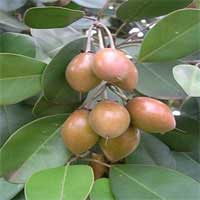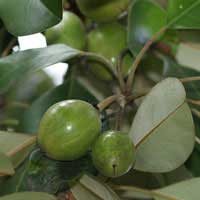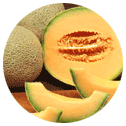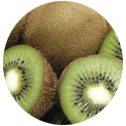 Full List of Fruits
Full List of Fruits  Wongi fruit
Wongi fruitWongi fruit
Scientific name - Manilkara kauki
Manilkara kauki commonly known as Wongi is a plant in the subfamily Sapotoideae which has its roots in the Sapotaceae family. Having a dense crown, the tree reaches to a height of 30 m. In the axils of the leaves, the flowers are yellowish-white in color. On the upper leaf face, the leaves are stiff, less sharp and are dark green and pale in color and silky below. On the top of branchlets, the leaves are crammed full. On top, they are shining dark green in color and grey beneath. Very sweet to taste, the orange-red fruit is edible and is 3-4 cm long, traditionally they are eaten by Torres Strait Islanders, who travel from island to island to harvest the crop. Containing 1 to 6 long lustrous seeds, the fruits are small and reddish-brown in color, ovoid-ellipsoid in shape. As a matter of fact, North Queensland varieties are orange-red in color and rather sweet when fully ripe. Calyx persistent at the base, the seeds is just about 20 x 19 mm and fruits are about 25 x 23 mm.
![]() Nutritional Value of Wongi fruit
Nutritional Value of Wongi fruit
| Calories | 380 |
| Fat | 17g |
| Carbs | 40g |
| Protein | 15g |
Wongi fruit can be used to make jams, jellies, desserts, and even pickles. It can also be used as a sweetener in place of sugar or honey.
The leaves of the wongi fruit can also be eaten and are often used in traditional Southeast Asian cuisine. The leaves are high in calcium, magnesium, and iron. They can also be cooked or used to make tea.
The seeds of the wongi fruit can also be eaten or ground into a powder and added to food. The powder is a great source of protein and can be used as a natural energy booster.
The rind of the fruit can be dried and used for medicinal purposes. It is believed to have anti-inflammatory and antiseptic properties and can be used to treat stomach ailments, skin infections, and even cancer.
Wongi fruit is a great source of nutrition and can be used in many different ways. The fresh fruit is great for snacking and can be used in a variety of recipes. The leaves, seeds, and rind can also be used for medicinal purposes and to make a variety of dishes.
Timber of the tree is highly functional in several ways; in Indonesia the wood has a good reputation for usage of furniture and fine carving. With the reddish lines, the heartwood is brown, dark brown or reddish brown in color and the sapwood is light brown. Functional in heavy construction, they are also used for turnery and mills. Fine carvings made from this wood is prized high and sold on a fairly small scale in markets and shops in Indonesia. With that said, the wood is also used to make charcoal.
The first step in cultivating Wongi fruit is to choose a suitable location for planting. The area should have plenty of sunlight and well-draining soil. The soil should also be rich in organic matter, as this will help to keep the plants healthy and productive.
The next step is to prepare the soil for planting. This involves tilling the soil, adding organic matter, and improving the drainage. After this, the seeds can be planted about 1 to 2 inches deep.
Once the plants have established, they should be regularly watered, fertilized, and pruned. Organic fertilizers should be used to provide the plants with the necessary nutrients, and pruning should be done to encourage growth and keep the plants healthy.
Harvesting of Wongi fruit should take place when they are ripe, which is usually around 4 to 5 months after planting. After harvesting, the fruit should be washed, peeled, and eaten or stored for later use.
Wongi fruit is a delicious, nutritious fruit that can be enjoyed either fresh or cooked. With proper cultivation, Wongi fruit can be enjoyed for many years to come.
Successive in subtropical areas, it is a plant of the lowland tropics that is usually found in drier regions and less elevations of 500 meters. Having the tolerance capacity of light frosts together with a wide range of soils, it best thrives in sandy loam soils. It can flower and fruit all year round given in some specific areas.
The propagation of Wongi fruit is a complicated and time-consuming process which involves several different techniques. The first step is to create a seed bed to facilitate germination. The soil should be well-drained and rich in organic matter. The seeds should then be sown directly into the seed bed and lightly covered with soil.
Once the seeds have germinated, the seedlings should be transplanted into individual pots. The pots should have drainage holes and should be filled with a potting mix which is rich in nutrients. The young plants should be kept in a warm, sunny location and watered regularly.
Once the plants are established and have reached a suitable size, they can be transplanted into the desired location. The soil should be well-drained, moist and rich in organic matter. The plants should be spaced at least 3 feet apart, to allow for adequate light and air circulation.
To ensure a healthy crop of Wongi fruit, regular fertilizing is necessary. A balanced fertilizer should be applied every two weeks, to provide the plants with the nutrients they need to thrive. Additionally, the plants should be pruned regularly and dead or diseased branches should be removed.
The Wongi fruit is ready for harvesting when the skin turns yellow. The fruit should be harvested carefully, to avoid damaging the skin and reducing the shelf life. The harvested fruit should be washed and stored in a cool, dry place.
Propagation of Wongi fruit is a lengthy process, but the resulting crop of sweet and juicy fruit makes the effort worthwhile.
Processed and clean seed do not have dormancy and requires no pre-treatment. In order to boost up germination rates, seeds are soaked in water for three periods of 24 hours before sowing using fresh water each time. Seeds are best sown in shady position, either in individual containers or in a nursery seedbed. Subsequent to sowing, it may take a period of 2.5 - 5 weeks for the germination process to take lead. When they become large enough to handle, it is highly suggested that you prick out the seedlings into individual containers and plant them into permanent positions when they are 12 months old or have at least four true leaves.


















